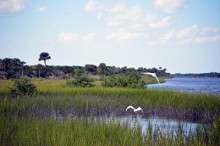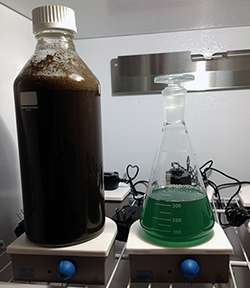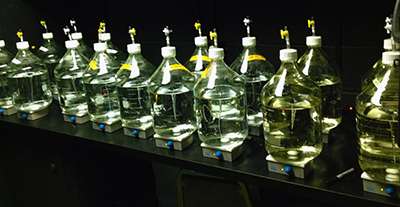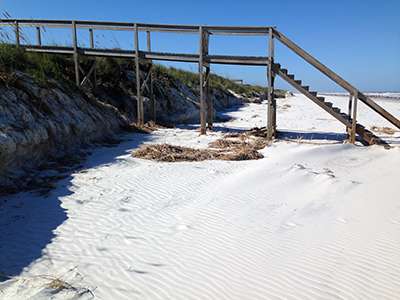Salt marshes like this one near St. Augustine, Florida, have stored organic carbon for hundreds to thousands of years in a low oxygen environment. Credit: Environmental Molecular Sciences Laboratory
Coastal environments supporting seagrasses, salt marshes and mangroves are storehouses for vast reserves of organic carbon known as blue carbon. These reservoirs have trapped organic carbon beneath the surface for hundreds to thousands of years in a low oxygen environment.
Unfortunately, coastal zones are changing due to rising sea levels and human encroachment. The combination of erosion and habitat destruction is allowing the trapped blue carbon to mix with seawater. Organisms in seawater are consuming the organic carbon and releasing carbon dioxide into the atmosphere.
"There's growing interest in blue carbon habitats, because they perform a natural and valuable service by sequestering CO2," says Thomas Bianchi, Jon and Beverly Thompson Endowed Chair of Geological Sciences at the University of Florida. "Coastal plants use the CO2 to grow through photosynthesis, but they also store it for long periods in the soils and sediments they live in. That's unique, because other plant habitats cycle CO2 out of their soils into the atmosphere much quicker."
Bianchi is a co-principal investigator studying the conversion of blue carbon to CO2 as part of a fiscal year 2017 Facilities Integrating Collaborations for User Science proposal. Through FICUS, Bianchi and colleagues will use the expertise and capabilities of EMSL, the Environmental Molecular Sciences Laboratory, a DOE Office of Science user facility at Pacific Northwest National Laboratory, and the DOE Joint Genome Institute, also a DOE Office of Science user facility at Lawrence Berkeley National Laboratory.
The research team includes Co-PIs Andrew Ogram and Todd Osborne, postdoctoral associate Ana Arellano, and graduate students Elise Morrison and Derrick Vaughn, all with the University of Florida; Co-PI Nicholas Ward, a scientist at the Pacific Northwest National Laboratory; and Yina Liu, an EMSL postdoctoral researcher. A self-funded study, support comes from the Thompson endowment and the University of Florida.
The team members made leachates out of peat (the brown one) and stable isotopically labeled algae (the green one). They soaked the materials in water for a day at room temperature in the dark, then filtered the material to leave only the dissolved organic carbon. Credit: Environmental Molecular Sciences Laboratory
"We're interested in studying what happens when you take this big carbon sink in coastal soils and sediments, and you start carving at it with sea level rise and wave erosion," says Bianchi. "What controls how quickly that carbon gets converted back into CO2?"
Priming decomposition
Priming is one of the factors affecting the speed stored carbon becomes CO2. For example, microbes have difficulty breaking down straw. Mixing straw with alfalfa accelerates the decomposition process. The microbes quickly eat the alfalfa, but they also break down the straw. The presence of more digestible material primes the straw to be broken down.
Scientists have studied the priming effect in soils, but few studies have investigated priming in coastal systems. In this study, priming is the mixing of decayed higher plant material (plants with rooted systems) with coastal algae to allow microbes to break it down faster.
"We hypothesized that the breakdown of the stored blue carbon would be much faster in the presence of algae than in the absence of it," says Bianchi.
The team performed a set of incubations in a temperature-controlled dark room. There were 36 bottles total with four different treatments, three time points for collecting genomic material and three replicates per treatment/time point. Credit: Environmental Molecular Sciences Laboratory
Bianchi's team tested the hypothesis with a series of experiments performed at the University of Florida Whitney Laboratory for Marine Bioscience using seawater, an algae mixture, and coastal peat from Florida wetlands in four treatments – (1) seawater control, (2) seawater and algae mixture, (3) seawater and peat, and (4) seawater, algae mixture and peat. They measured the amount of CO2 produced over time by the four treatments. The team used isotopes as chemical markers to track the source of the CO2 molecules. Samples from these experiments were submitted to EMSL and the DOE JGI for high-resolution measurements of organic carbon composition and microbial genetic responses.
"Our preliminary data supports our hypothesis," says Bianchi. "In the presence of algae you get more blue carbon peat being converted to CO2."
The priming effect could be more dramatic as oceans become greener with algae due to pollution from fertilizers and other farm runoff.
Getting to know microbes
The project is also using EMSL and DOE JGI capabilities to study microbial communities that convert peat into CO2. They want to know how communities change in the presence and absence of algae. They are also interested in how the microbes decompose peat, including what enzymes they use. The team is using EMSL's mass spectrometry and nuclear magnetic resonance expertise and capabilities for this portion of the research.
Crescent Beach, near the University of Florida Whitney Laboratory for Marine Bioscience, after Hurricane Matthew shows how potentially sensitive coastal areas are to erosion (the intracoastal waterway is on the other side of the dunes and the hurricane formed a new inlet). Credit: Environmental Molecular Sciences Laboratory
"Being a FICUS project gives us a fantastic opportunity to use two of the best research facilities in the world," says Bianchi. "Working with EMSL and (DOE) JGI will help us understand how priming works, because we really don't know all the details about it."
Bianchi says the study's findings could improve climate models as the global models scale down. Sophisticated climate models are starting to account for regional effects. The findings could be added to a regional-based model that includes a conversion of land lost to CO2 with priming as an enhancement factor.
"There's a bigger story," says Bianchi. "A greener coastal ocean and a destabilized coastal environment due to sea level rise and land use changes are causing a rapid turnover of stored carbon that's hundreds and thousands of years old being converted into CO2 in part through the priming process."
Provided by Environmental Molecular Sciences Laboratory


























